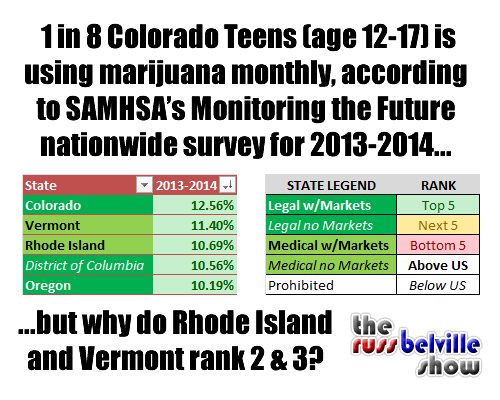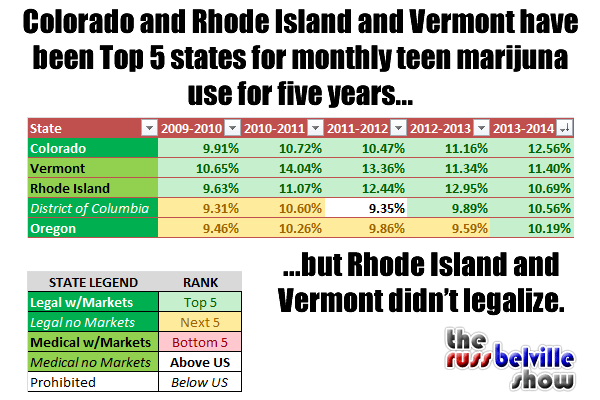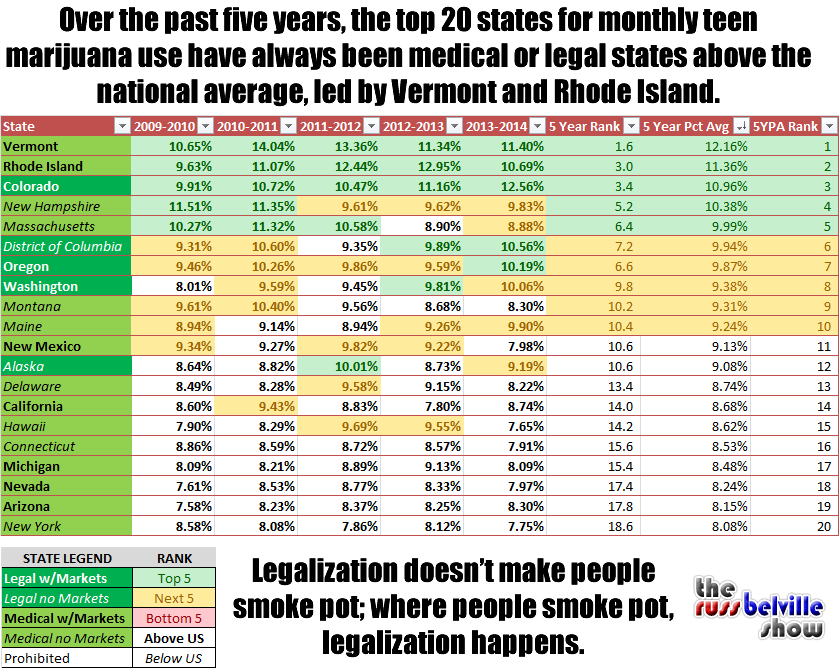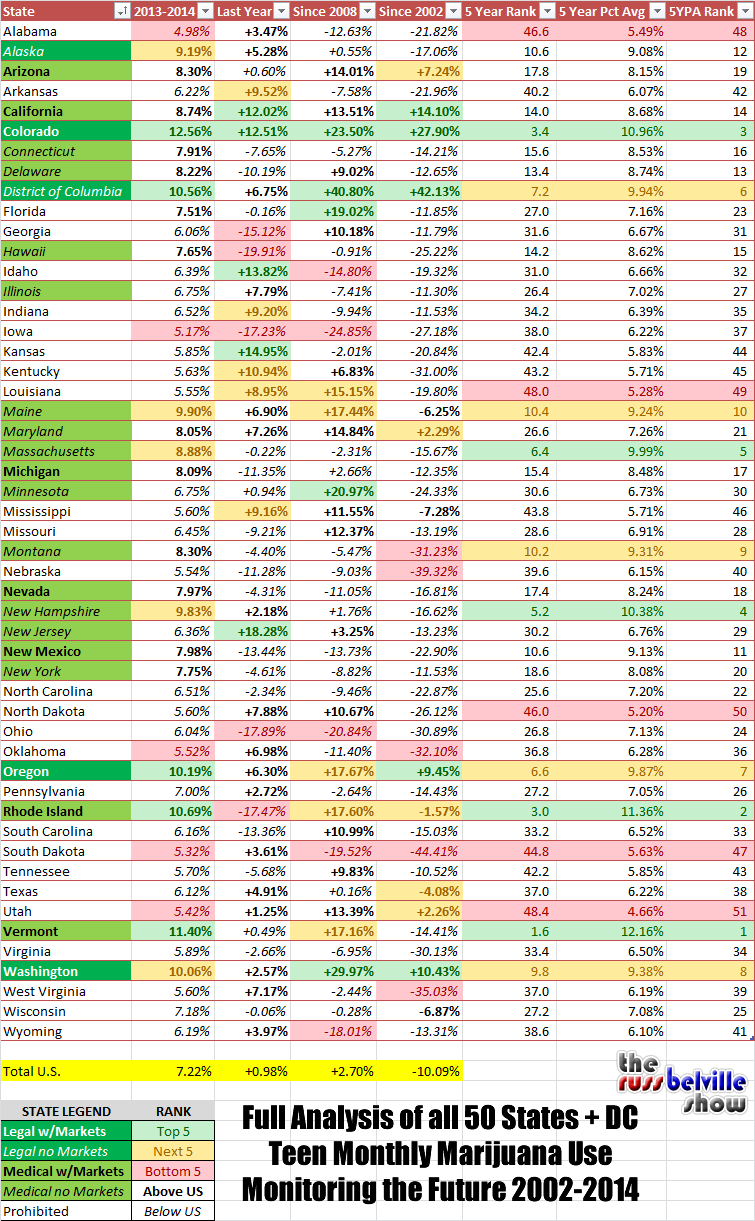
Prohibition propagandists like the Joker to my Batman, Kevin Sabet of Project SAMUEL (Smart Approaches to Marijuana Use… Except Legalization), are desperately crying out to the media for attention to this report from the Substance Abuse & Mental Health Services Administration (SAMHSA) that explains how Colorado youth aged 12-17 now exhibit the highest rate of monthly teen marijuana use, now at 12.56%.
That’s one-in-eight teenagers toking at least once per month.
Joel M. Warner in the Int’l Business Times explains how Sabet frets about the media’s blackout of the news:
“What went through our heads was, ‘This is big news,’” says Sabet. “We felt this would absolutely reach a wide audience.” After all, the day before, the National Institutes of Health’s 2015 Monitoring the Future survey, which found that nationwide teen marijuana use had fallen slightly overall, had received widespread coverage. Wouldn’t this report generate major headlines, too?
Sabet rushed out a press release. Then he waited for the onslaught of calls he expected from reporters. Instead, all he heard was crickets.
Why the crickets? Because there are three problems the Sabets of the world have to deal with now that they didn’t have to contend with in the 1980s & 1990s…
1) Google
We no longer have to hear a scary statistic from a propagandist and take it at face value. Now we can actually look it up for ourselves.
Kevin Sabet runs to the media and, like Chicken Little, proclaims that the sky is falling in Colorado:
…Colorado now leads the country in past-month youth marijuana use, after legalizing marijuana in 2012. The state claims this dubious distinction after being in third place in the 2012-2013 report, and in fourth place in the 2011-2012 study.
[…]
Other states that have legalized marijuana finished in the top six: the District of Columbia (4th), Oregon (5th), and Washington state (6th).
So the media look up the very report Sabet so desperately wants to be given scrutiny, and right there, under its heading, “CHANGES OVER TIME IN ADOLESCENT PAST MONTH MARIJUANA USE”, it reads:
On an individual state level, three states experienced a statistically significant decrease in the rate of adolescent past month marijuana use (Hawaii: from 9.55 to 7.65 percent, Ohio: from 7.36 to 6.04 percent, and Rhode Island: from 12.95 to 10.69 percent). The remaining 47 states and the District of Columbia experienced no change in past month marijuana use.
No statistically significant change. But it didn’t take a mathematics degree for most journalists to figure out that Colorado has been a top five monthly teen marijuana use state for five straight years, along with Rhode Island and Vermont, which haven’t legalized marijuana.
2) Excel
We no longer have to accept the scary statistics from propagandists because we can access the data for ourselves.
The Monitoring the Future survey has been conducted by the government since 1975. All the data are published online and you can import them into Excel (or any spreadsheet) and crunch the numbers for yourself.
Keep in mind that there was “no [statistically significant] change in past month marijuana use” according to the report’s authors. But if Kevin Sabet wants to play by his implicit rules that Colorado’s increase from 11.56% to 12.56% over the past year means something, then all those figures for all the states are in play.
The top 20 states for teen marijuana use have rates that are greater than the national average and they have been consistently for the past five years. They are all medical marijuana or legalized marijuana states, but with differences as to whether they have legal markets (dispensaries) or not.
Eight states have consistently been in the top ten (5 Year Rank Average): Vermont, Rhode Island, Colorado, New Hampshire, Massachusetts, Washington DC, Oregon, and Washington. What changed in those states over the past five years?
- Vermont: Got two dispensaries opened in 2013 and their rate didn’t change a bit (where “bit” <=0.3%);
- Rhode Island: Got one dispensary opened in 2013 and they were one of three states with a statistically significant decline;
- Colorado: Legalized in 2012 and their rate increased slightly (where “slight” > 0.3% but still statistically insignificant);
- New Hampshire: Passed medical marijuana in 2013 and their rate didn’t change a bit;
- Massachusetts: Passed medical marijuana in 2012 and their rate didn’t change a bit;
- Washington DC: Legalized in 2014 after rate increased slightly;
- Oregon: Tried to legalize in 2012 and rate didn’t change a bit, legalized in 2014 after slight increase;
- Washington: Legalized in 2012 and rate increased slightly.
Marijuana legalization and reform doesn’t create marijuana smokers any more than legalizing gay marriage created gay people or passing the Civil Rights Act created black people. Where there are marijuana smokers, legalization and reform will happen because people by nature demand their rights.
3) New Media
The final nail in Kevin Sabet’s What About the Children?!? scare coffin is our vast superiority in the online realm. Just this author alone has more Twitter and Facebook and Instagram followers than all Kevin Sabet and all his Project SAM acolytes combined.
Then multiply by hundreds of people like me how are dedicated activists for the cause of legalization and the now-burgeoning industry of marijuana and marijuana media. So not only do we have facts, science, reason, logic, truth, evidence, compassion, and love on our side, we’ve got the megaphone now to broadcast it.
Gone are the days when the drug czar’s office could pay Hollywood scriptwriters to place anti-marijuana plotlines in sitcoms and family dramas. The readers of newspapers and watchers of the CBS Evening News are dinosaurs and the majority of the under 65 denizens of the new online world have tried marijuana for themselves at least once, most likely when they were teenagers.
You can’t scare them anymore, Kevin.










